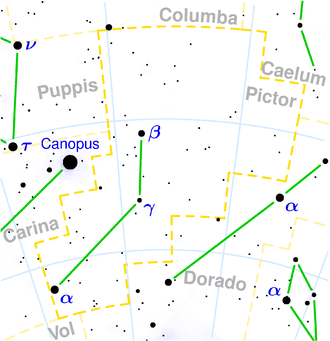NGC 1705
| Galaxy NGC 1705 |
|
|---|---|
![NGC 1705 [1] Hubble Space Telescope](https://upload.wikimedia.org/wikipedia/commons/thumb/5/54/NGC_1705.jpg/300px-NGC_1705.jpg)
|
|
| NGC 1705 Hubble Space Telescope | |
| AladinLite | |
| Constellation | painter |
|
Position equinox : J2000.0 , epoch : J2000.0 |
|
| Right ascension | 04 h 54 m 13.50 s |
| declination | -53 ° 21 ′ 39.8 ″ |
| Appearance | |
| Morphological type | SA0- / HII / BCDG |
| Brightness (visual) | 11.8 mag |
| Brightness (B-band) | 12.8 mag |
| Angular expansion | 1.9 ′ × 1.4 ′ |
| Position angle | 50 ° |
| Surface brightness | 12.9 mag / arcmin² |
| Physical data | |
| Affiliation | isolated |
| Redshift | 0.002112 ± 0.000019 |
| Radial velocity | 633 ± 6 km / s |
|
Stroke distance v rad / H 0 |
(20 ± 1) x 10 6 ly (6.15 ± 0.45) Mpc |
| diameter | 2000 ly |
| history | |
| discovery | John Herschel |
| Discovery date | December 5, 1834 |
| Catalog names | |
| NGC 1705 • PGC 16282 • ESO 158-013 • IRAS 04531-5326 • 2MASX J04541350-5321398 • SGC 045306-5326.5 • GC 937 • h 2679 • GALEX ASC J045413.62-532138.3 • HIPASS J0454-53 • 2MIG 638 | |
NGC 1705 is an elliptical dwarf galaxy with extensive star formation regions of the Hubble type E / S0 in the constellation Painter in the southern sky . It is an estimated 28 million light years from the Milky Way and about 15,000 light years across .
In the center of the galaxy is a huge star cluster , which probably formed during a phase of violent star formation, a so-called starburst , about 26 to 31 million years ago. NGC 1705 is particularly suitable as a study object , since some astronomers suspect that dwarf galaxies were among the first star clusters in the early universe .
The object was discovered on December 5, 1834 by the British astronomer John Herschel .
Web links
- Hubble Space Telescope
- The Stars of NGC 1705 - Astronomy Picture of the Day of April 23, 2003.
- astronews.com: Young stars in the center of NGC 1705 March 7, 2003
- astronews.com: Picture of the day March 1, 2013
